Welcome
World trade patterns show that while many developing countries are now playing an increasing role in trade, many other—and particularly least developed countries who account for less than 1% of all global trade—remain stranded on the margins. Still heavily reliant on natural resource-based products and raw materials for their exports, these countries are highly vulnerable to economic and environmental shocks.
The transition to an inclusive green economy represents many significant opportunities. By harnessing the increasing global demand for environmental goods and services, as well as consumer demand for more sustainable products, countries can diversify their economies, reduce their commodity dependence and boost their competitiveness. Thus, societies promote long-term, sustainable development while also strengthening their capacity to tackle the manifold environmental challenges lying ahead.
Trade can also power a green economic recovery from COVID-19. Global demand for environmental goods and services is expected to rise as countries roll out economic stimuli with larger earmarks for climate-friendly solutions. While this course was developed prior to the outbreak of COVID-19, its contents therefore remain relevant to current policy discussions.
One practical challenge lies in ensuring that countries are both aware of these opportunities and that they possess the knowledge and skills to take advantage of them. To address this challenge, the course sets out to provide interested participants from government, business, and civil society with an introduction to the various approaches that may be taken to harness green trade opportunities.
If you encounter any difficulty or if you have any questions, please consult our help page.
What will you learn?
Participants completing the course will be able to:
- Outline the evolution of legal and governance frameworks underpinning the trade and green economy interface
- Identify perceived challenges and potential opportunities related to trade in the transition to a green economy
- Describe enabling policy conditions to foster green trade practices
- Highlight sectoral case studies of green trade in action
Course structure at a glance
The course aims to provide participants with a solid understanding of the policy instruments and enabling conditions needed for countries to advance the green economy transition via green trade, and vice-versa. It contains four lessons, each taking approximately 20 minutes to complete:
- The trade and environment interface
- Perceived tensions and synergies between trade liberalization and the green economy
- Enabling conditions and policy design for green trade
- Seizing sectoral opportunities
Get a certificate!
A final quiz composed of ten multiple choice questions serves to assess learners’ achievement of the course’s learning objectives. The quiz can be taken at any time and attempted up to three times. Learners need to pass the quiz with a score of at least 70%. Once the quiz is successfully passed, a Certificate of Completion will be available for download on the course’s Certification page.
Partners
This course has been developed under the umbrella of the Partnership for Action on Green Economy (PAGE). PAGE brings together five UN agencies – UN Environment, International Labour Organization, UN Development Programme, UN Industrial Development Organization, and UN Institute for Training and Research – whose mandates, expertises and networks combined can offer integrated and holistic support to countries on inclusive green economy.

